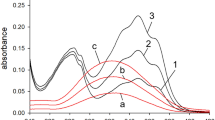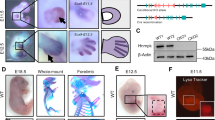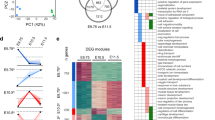Abstract
Retinoic acid may be the natural morphogen used to generate digit pattern in the chick limb bud1. It has been proposed that retinoic acid acts by binding to a cellular retinoic acid-binding protein (CRABP) and then entering the nucleus to alter the pattern of gene activity2,3. High-affinity receptors that bind both retinoic acid and DNA and are analogous to the steroid receptors have been identified4–7. But the concentration of endogenous retinoic acid in the limb8 and the binding coefficient of the nuclear receptors5 indicate that they are saturated throughout the limb. Here we investigate the CRABP distribution in the developing chick limb bud. We find CRABP in the area of intense morphogenetic activity at the tip, with a differential distribution across the anteroposterior axis, the high point being at the anterior margin. Retinoic acid also forms a concentration gradient across the limb bud, but is highest on the posterior side8. We propose that CRABP could be reducing the effective concentration of retinoic acid reaching the nucleus to a level appropriate for the differential regulation of gene transcription, providing a spatially modulated morphogenetic gradient of information for digit formation.
This is a preview of subscription content, access via your institution
Access options
Subscribe to this journal
Receive 51 print issues and online access
$199.00 per year
only $3.90 per issue
Buy this article
- Purchase on SpringerLink
- Instant access to full article PDF
Prices may be subject to local taxes which are calculated during checkout
Similar content being viewed by others
References
Eichele, G., Tickle, C. & Alberts, B. M. J. Cell Biol. 101, 1913–1920 (1985).
Chytil, F. & Ong, D. A. in The Retinoids (eds Sporn, M. B., Roberts, A. B. & Goodman, D. S.) 89–123 (Academic, Orlando, Florida, 1984).
Takase, S., Ong, D. E. & Chytil, F. Archs. Biochem. Biophys. 247, 328–334 (1986).
Petkovich, M., Brand, N. J., Krust, A. & Chambon, P. Nature 330, 444–450 (1987).
Giguere, V., Ong, E. S., Segui, P. & Evans, R. M. Nature 330, 624–629 (1987).
Brand, N. et al. Nature 332, 850–853 (1988).
Benbrook, D., Lernhardt, E. & Pfahl, M. Nature 333, 669–672 (1988).
Thaller, C. & Eichele, G. Nature 327, 635–628 (1987).
Tickle, C., Alberts, B., Wolpert, L. & Lee, J. Nature 296, 564–566 (1982).
Summerbell, D. J. Embryol. exp. Morph. 78, 269–289 (1983).
Tickle, C., Summerbell, D. & Wolpert, L. Nature 254, 199–202 (1975).
Maden, M. & Summerbell, D. J. Embryol. exp. Morph. 97, 239–250 (1986).
Porter, S. B., Ong, D. E. & Chytil, F. J. Androl. 6, 197–212 (1985).
Wolpert, L., Lewis, J. & Summerbell, D. in Cell Patterning (Ciba Found. Symp. 29) 95–130 (Associated Scientific, Amsterdam, 1975).
Summerbell, D. J. Embryol. exp. Morph. 32, 227–237 (1974).
Summerbell, D. & Wolpert, L. Nature new Biol. 239, 24–26 (1972).
Robertson, M. Nature 330, 420–421 (1987).
Laemmli, U.K. Nature 227, 680–685 (1970).
Author information
Authors and Affiliations
Rights and permissions
About this article
Cite this article
Maden, M., Ong, D., Summerbell, D. et al. Spatial distribution of cellular protein binding to retinoic acid in the chick limb bud. Nature 335, 733–735 (1988). https://doi.org/10.1038/335733a0
Received:
Accepted:
Issue date:
DOI: https://doi.org/10.1038/335733a0
This article is cited by
-
Using mechanistic Bayesian networks to identify downstream targets of the Sonic Hedgehog pathway
BMC Bioinformatics (2009)
-
1H and 15N resonance assignments and secondary structure of cellular retinoic acid-binding protein with and without bound ligand
Journal of Biomolecular NMR (1994)
-
Stable, position-related responses to retinoic acid by chick limb-bud mesenchymal cells in serum-free cultures
In Vitro Cellular & Developmental Biology - Animal (1994)



